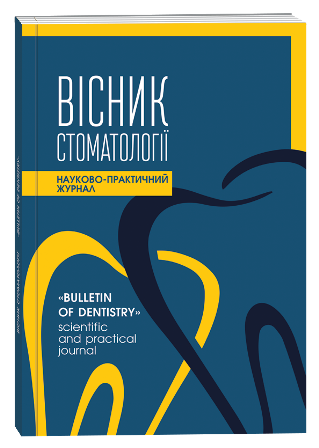TOPICAL ASPECTS OF DIAGNOSIS AND PROGNOSIS OF TEMPOROMANDIBULAR JOINTS DISEASES
DOI:
https://doi.org/10.35220/2078-8916-2024-52-2.9Keywords:
temporomandibular joints, diseases, symptoms, axiography, condylography, prognosis.Abstract
Aim: to increase the efficiency of diagnosing diseases of the temporomandibular joint (TMJ) by assessing a set of condylographic indicators, developing prognostic algorithms for the development and course of this pathology. Material and methods. The study was conducted with the participation of 410 patients with TMJ pathology aged 25–65 (32±12.7) years. The study design was clinical retrospective cross-sectional comparative. As part of the complex examination, palpatory assessment of the state of the masticatory muscles and the TMJ, condylography (axiography), computed tomography, teleradiography, occlusiography, determination of the range of motion of the mandible, analysis of jaw models in the articulator, etc. were performed, the data were analyzed using standard logical and statistical methods at a critical p-level of 0.05. Results and discussion. A retrospective analysis of the examination results and treatment methods of patients with TMJ diseases was performed. The clinical efficacy of the proposed and standard approaches to the diagnosis of patients with TMJ pathology was compared. The foundations for the development of prognostic mathematical models and a program for the examination of patients, which takes into account the development, course, timing and success of treatment of TMJ diseases, are laid. On the basis of clinical, condylographic, articulation diagnostic methods, the advantages of the proposed methods of diagnosis, prognosis and treatment of patients with TMJ pathology are substantiated. Conclusions: it is recommended to use the developed modified program of examination of patients, which, in addition to the standard approach, is based on clinical, condylographic, articulation diagnostic methods with mathematical prognostic modeling by the method of sequential analysis of A. Wald in the modification of E. Gubler, A. Genkin and using the algorithm for assessing the probability of progression of TMJ diseases. Prospects for further research are to replenish primary data, improve mathematical models, test and implement individualized prognostic algorithms for assessing the progression of TMJ diseases with the determination of their clinical effectiveness.
References
Matheson, E. M., Fermo, J. D., & Blackwelder, R. S. (2023). Temporomandibular Disorders: Rapid Evidence Review. American Family Physician, 107(1), 52–58.
Kalladka, M., Young, A., Thomas, D., Heir, G. M., Quek, S. Y. P., & Khan, J. (2022). The relation of temporomandibular disorders and dental occlusion: A narrative review. Quintessence International (Berlin, Germany: 1985), 53(5), 450–459. https://doi.org/10.3290/j.qi.b2793201
Tran, C., Ghahreman, K., Huppa, C., & Gallagher, J. E. (2022). Management of temporomandibular disorders: A rapid review of systematic reviews and guidelines. International Journal of Oral and Maxillofacial Surgery, 51(9), 1211–1225. https://doi.org/10.1016/j.
ijom.2021.11.009
Song, Z., Yuan, S., Liu, J., Bakker, A. D., Klein-Nulend, J., Pathak, J. L., & Zhang, Q. (2022). Temporomandibular joint synovial chondromatosis: An analysis of 7 cases and literature review. Science Progress, 105(3), 368504221115232. https://doi.org/10.1177/00368504221115232
Ozhohan, R., Rozhko, M. M., Ozhogan, Z. R., Khopta, R. M., & Miziuk, L. (2020). Modern methods of patients treatment with dentition defects combined with functional disorders of the temporomandibular joint. Wiadomosci Lekarskie (Warsaw, Poland: 1960), 73(10),
–2245.
Zhang, C.-X., Wang, T.-Q., Liu, D.-Q., Duan, X.-N., Zhi, C., Wang, J., & Lin, C. (2022). Characteristics of condylography
during masticatory movement in patients with Class Ⅱ division 1 malocclusion and temporomandibular disorders. Shanghai Kou Qiang Yi Xue = Shanghai Journal of Stomatology, 31(4), 429–434.
Sah, M. K., Abdelrehem, A., Chen, S., Shen, P., Jiao, Z., Hu, Y. K., Nie, X., & Yang, C. (2022). Prognostic indicators of arthroscopic discopexy for management of temporomandibular joint closed lock. Scientific Reports, 12(1), 3194. https://doi.org/10.1038/s41598-022-07014-9
Muñoz-Guerra, M. F., Rodríguez-Campo, F. J., Escorial-Hernández, V., Brabyn, P. J., Fernández-Domínguez, M., & Naval-Gías, L. (2021). Is There a Relationship Between Age, Personal Factors or Surgical Findings, and Outcome After Temporomandibular Joint Arthroscopy? Journal of Oral and Maxillofacial Surgery: Official Journal of the American Association of Oral and Maxillofacial
Surgeons, 79(5), 1000–1008. https://doi.org/10.1016/j.joms.2020.12.016
Attia, H. S., Mosleh, M. I., Jan, A. M., Shawky, M. M., & Jadu, F. M. (2018). Age, gender and parafunctional habits as prognostic factors for temporomandibular joint arthrocentesis. Cranio: The Journal of Craniomandibular Practice, 36(2), 121–127. https://doi.
org/10.1080/08869634.2017.1292175
Eşer, G., Duman, Ş. B., Bayrakdar, İ. Ş., & Çelik, Ö. (2023). Classification of temporomandibular joint osteoarthritis on cone beam computed tomography images using artificial intelligence system. Journal of Oral Rehabilitation, 50(9), 758–766. https://doi.org/10.1111/joor.13481
Ozhogan, Z. R., & Krokhmal, A. V. (2023b). The role of clinical parameters in the patient examination program as an optimization means for complex diagnosis and prognosis of temporomandibular joint diseases. Art of Medicine, 104–109. https://doi.org/10.21802/
artm.2023.2.26.104
Ozhogan, Z. R., & Krokhmal, A. V. (2023a). Optimization of complex diagnosis and forecasting of temporomandibular joint diseases by assessing the probability of progression. Art of Medicine, 147–153. https://doi.org/10.21802/artm.2023.4.28.147
Wald, A. (1947). Sequential analysis. J. Wiley & Sons ; Chapman & Hall.
Lang, T. A., & Secic, M. (Eds.). (2006). How to Report Statistics in Medicine: Annotated Guidelines for Authors, Editors, and Reviewers (2nd edition). American College of Physicians.









